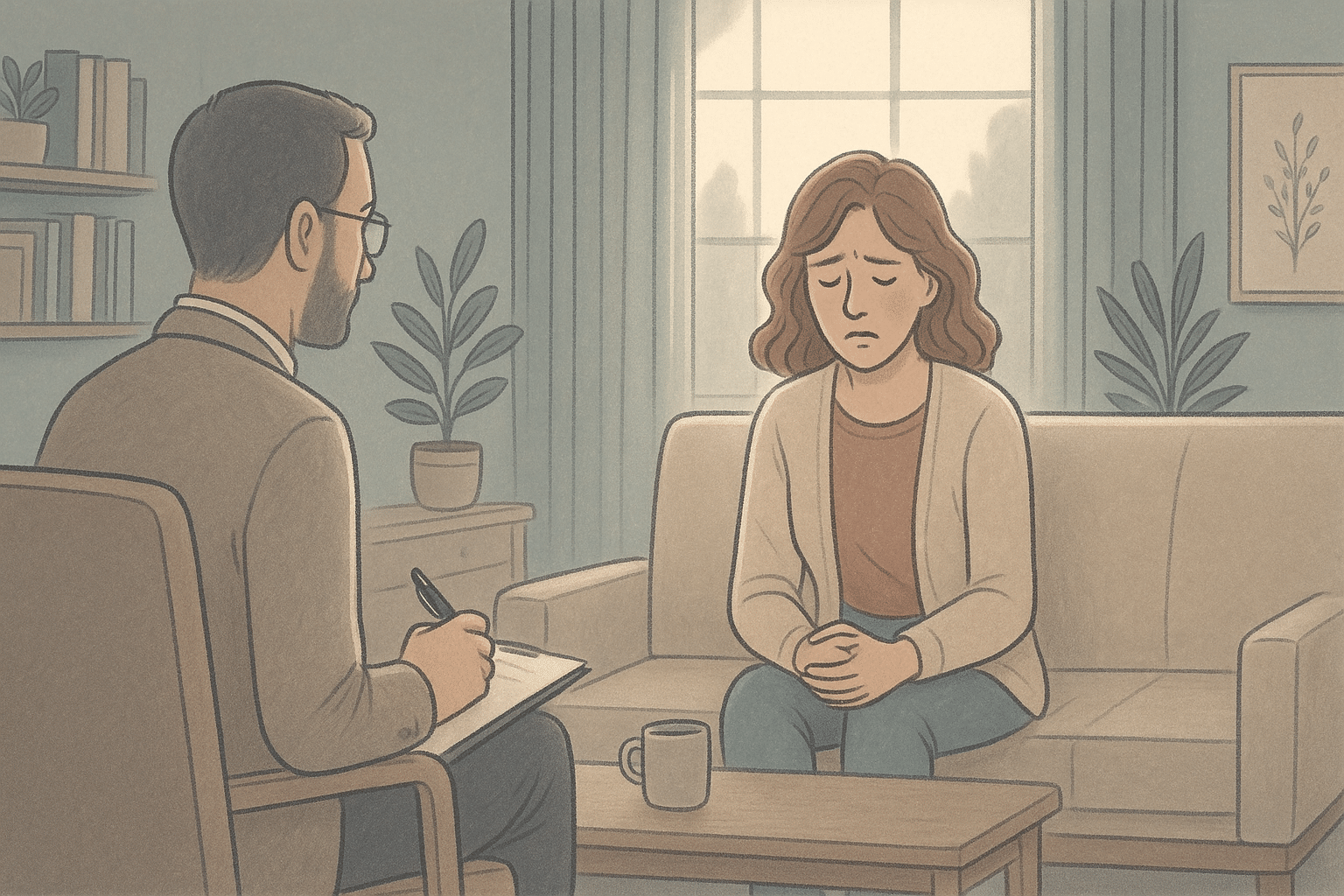Key Takeaways
- Lurasidone (Latuda) is a second-gen antipsychotic used to treat schizophrenia and schizoaffective disorder.
- Lurasidone is a good choice for long-term treatment because it has a lower risk of side effects like weight gain.
- The medication helps manage both psychotic symptoms, such as hallucinations and delusions, and mood disturbances in schizoaffective disorder.
- The usual dosage for Lurasidone is between 40 and 160 mg a day.
- Some people experience drowsiness, nausea, and dizziness as side effects, but Lurasidone is generally well-tolerated.

What is Schizophrenia & Schizoaffective Disorder?
Schizophrenia is a mental health condition that affects how a person thinks, feels, and behaves. This disorder often involves symptoms like hallucinations, delusions, and disorganized thinking—making it difficult for individuals to perceive reality accurately.1
Schizoaffective disorder is a bit more complex. It combines symptoms of schizophrenia with mood disorder features, such as depression or bipolar disorder. People with schizoaffective disorder have psychotic symptoms like hallucinations and delusions—similar to schizophrenia—along with significant mood disturbances. Because of its dual nature, schizoaffective disorder is particularly challenging to diagnose.2
| A Mission For Michael: Expert Mental Health Care Founded in 2010, A Mission For Michael (AMFM) offers specialized mental health care across Southern California, Minnesota, and Virginia. Our accredited facilities provide residential and outpatient programs, utilizing evidence-based therapies such as CBT, DBT, and EMDR. Our dedicated team of licensed professionals ensures every client receives the best care possible, supported by accreditations from The Joint Commission and the California Department of Health Care Services. We are committed to safety and personalized treatment plans. Start your recovery journey with AMFM today! |
Causes of Schizophrenia & Schizoaffective Disorder
Scientists don’t have a single, clear answer for what causes schizophrenia or schizoaffective disorder. But research shows lots of different things can play a part in these complex mental health conditions.
Genetics are an important factor, as both schizophrenia and schizoaffective disorder often run in families – but just because someone has a family member with one of these disorders doesn’t mean they’ll also develop it.
Environmental factors also play a role—exposure to stress during childhood, complications during pregnancy, or living in poverty can increase the likelihood of developing schizophrenia or schizoaffective disorder. Research also found that people with these disorders often have differences in brain structure and function. For example, some people with schizophrenia have variations in the size of certain brain areas, or in the connections between them, which may influence how they process information and emotions.1

Symptoms of Schizophrenia & Schizoaffective Disorder
Schizophrenia and schizoaffective disorder can affect people in different ways, but they usually impact a person’s thinking, perception, and ability to function. Both have similar symptoms—especially in their psychotic features—but schizoaffective disorder also includes mood-related symptoms such as depression or mania.
Common symptoms of schizophrenia include:1
- Cognitive symptoms (e.g. Trouble with attention, memory, and processing information)
- Delusions
- Disorganized thinking and speech
- Hallucinations
- Negative symptoms (e.g. A lack of motivation, reduced emotional expression, etc.)
Symptoms specific to schizoaffective disorder include:2
- Mood episodes: In addition to the psychotic symptoms mentioned above, people with schizoaffective disorder also experience periods of depression or mania.
- Depression can cause feelings of sadness, hopelessness, and fatigue.
- Manic episodes may involve increased energy, risky behaviors, and impulsive decisions.
Types of Schizophrenia & Schizoaffective Disorder
Schizophrenia and schizoaffective disorder have traditionally been grouped into a few different types based on their symptoms.
While newer guidelines focus on a spectrum approach, these classifications can still help us understand the unique ways these disorders manifest.
Types of Schizophrenia:4
- Paranoid Schizophrenia: Main symptoms are delusions and auditory hallucinations, often involving themes of persecution or conspiracy. People may experience intense paranoia, but usually keep their cognitive and emotional functions.
- Disorganized Schizophrenia (Hebephrenic Schizophrenia): The person may have trouble organizing their speech and behavior. They may also have trouble functioning day-to-day. While they may have hallucinations or delusions, they are typically less intense than in paranoid schizophrenia.
- Catatonic Schizophrenia: This type includes significant motor disturbances—like catatonic stupor (where the person is completely immobile) or catatonic excitement (where the person is excessively active). People may also exhibit unusual postures and echolalia (repeating others’ words).
- Undifferentiated Schizophrenia: Diagnosed when symptoms do not fit clearly into any other subtype, with individuals showing a mix of symptoms from various types.
- Residual Schizophrenia: This applies to people who have had schizophrenia and are currently showing mild or residual symptoms—such as social withdrawal or reduced emotional expression—without any prominent psychotic features.
Types of Schizoaffective Disorder:5
- Schizoaffective Disorder Bipolar Type: This type involves periods of mania, which may include increased energy, impulsivity, irritability, and psychotic symptoms like hallucinations or delusions. Major depressive episodes may also occur.
- Schizoaffective Disorder Depressive Type: Marked by major depressive episodes, like persistent sadness, low energy, and loss of interest, along with psychotic symptoms. Unlike the bipolar type, there’s no mania.
- Mixed Type: Though not always clear-cut, the mixed type includes both manic and depressive symptoms within the same episode, along with psychotic features that aren’t directly tied to mood changes.
Lurasidone (Latuda) & How It is Used for Schizophrenia & Schizoaffective Disorder

Lurasidone—sold as Latuda—is an atypical antipsychotic used to treat schizophrenia and bipolar depression. As a second-generation antipsychotic, it helps manage symptoms by balancing certain neurotransmitters in the brain—particularly dopamine and serotonin.3
Lurasidone is effective in reducing hallucinations, delusions, and mood instability, making it a valuable treatment for those with schizophrenia and schizoaffective disorder. This medication is widely prescribed because it has a good side effect profile, especially in terms of weight gain and metabolic health, which are often concerns with antipsychotic treatments.6
How Lurasidone (Latuda) Works
Lurasidone works by targeting specific receptors in the brain—mainly the dopamine D2 and serotonin 5-HT2A receptors. This dual mechanism helps ease psychotic symptoms by reducing dopamine overactivity—often linked to hallucinations and delusions.
This medication acts on the 5-HT7 receptor, contributing to improved mood and cognitive function. It doesn’t interact with other receptors (like histamine H1 and muscarinic M1), so it has a lower risk of side effects related to weight gain, sedation, and metabolic disruptions.6, 7
Lurasidone (Latuda)’s Effects on Schizophrenia & Schizoaffective Disorder
Lurasidone can be very effective in reducing the core symptoms of schizophrenia, including both positive symptoms (such as hallucinations and delusions) and negative symptoms (like social withdrawal and lack of motivation).
For schizoaffective disorder, lurasidone can help manage psychotic symptoms and stabilize mood when used with mood stabilizers or antidepressants. Studies show it improves patients’ overall quality of life, cognitive function, and social engagement—making it a well-rounded treatment for both conditions.8, 9
How Long Lurasidone (Latuda) Takes to Work
You’ll often notice the effects of lurasidone within the first week of treatment, particularly for reducing agitation and psychotic symptoms. For more substantial improvements, including reductions in hallucinations and mood stabilization, it may take 4 to 6 weeks.7
Lurasidone (Latuda) Doses
This medication is usually prescribed in doses ranging from 40-160 mg per day, depending on how severe the symptoms are and how the patient responds. Studies show doses of 80 mg and 120 mg are usually effective for many patients, but higher doses (up to 160 mg) may be used for acute symptoms. The starting dose is often 40 mg, and adjustments are made based on how the patient is doing and how they tolerate it.6, 8
Possible Side Effects of Lurasidone (Latuda)
Lurasidone is generally well-tolerated. Common side effects include drowsiness, restlessness, and nausea. Some patients may experience dizziness or stomach discomfort. Notably, lurasidone has minimal impact on weight and metabolic parameters, reducing the risk of diabetes and cardiovascular issues commonly associated with other antipsychotics.6, 7
Take the Next Step Toward Better Mental Health
At A Mission for Michael, we understand—living with severe mental health conditions like schizophrenia and schizoaffective disorder can be difficult. That’s why we provide 24/7 personalized care in a supportive, home-like environment.
We use evidence-based therapies, like Cognitive Behavioral Therapy and Dialectical Behavior Therapy, and experiential treatments, to help people recover long-term and improve their quality of life.
If you or someone you know needs a lot of care and support, our team is here to help. Get in touch today to find out how our approach can make a difference. Together, we can take the first step toward healing.
Start your recovery journey with AMFM today.
Frequently Asked Questions (FAQ)
What is Lurasidone (Latuda) used for?
Lurasidone (Latuda) is a second-generation antipsychotic medication used to treat schizophrenia and schizoaffective disorder. It helps manage psychotic symptoms like hallucinations and delusions, and mood disturbances in schizoaffective disorder.
How does Lurasidone work in treating schizophrenia and schizoaffective disorder?
Lurasidone targets specific brain receptors, including dopamine D2 and serotonin 5-HT2A receptors, to help reduce psychotic symptoms. It also works on serotonin 5-HT7 receptors, which helps keep your mood stable and improves your cognitive function.
What are the common side effects of Lurasidone?
Common side effects of Lurasidone include drowsiness, restlessness, nausea, dizziness, and stomach discomfort. But it has minimal impact on weight gain and metabolic health, making it a well-tolerated option compared to other antipsychotics.
How long does it take for Lurasidone to show effects?
Lurasidone may show noticeable effects—such as reduced agitation—within the first week of treatment. More significant improvements, like fewer hallucinations and more stable moods, occur after about 4-6 weeks.
Is Lurasidone effective for treating schizoaffective disorder?
Lurasidone is a great option for treating schizoaffective disorder. It helps manage psychotic symptoms and stabilizes mood when combined with mood stabilizers or antidepressants. It also improves cognitive function and overall quality of life for many patients.
Resources
1. https://www.nimh.nih.gov/health/topics/schizophrenia
2. https://www.ncbi.nlm.nih.gov/books/NBK541012/
3. https://www.ncbi.nlm.nih.gov/books/NBK541057/
4. https://www.medicalnewstoday.com/articles/192770#current-types
5. https://medlineplus.gov/genetics/condition/schizoaffective-disorder/
7. https://onlinelibrary.wiley.com/doi/10.1111/pcn.13221












